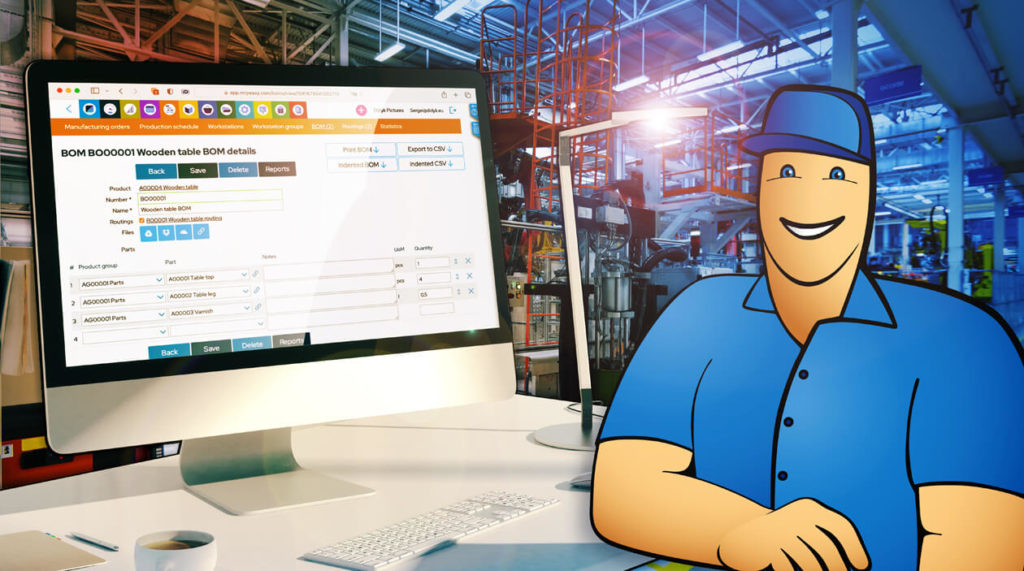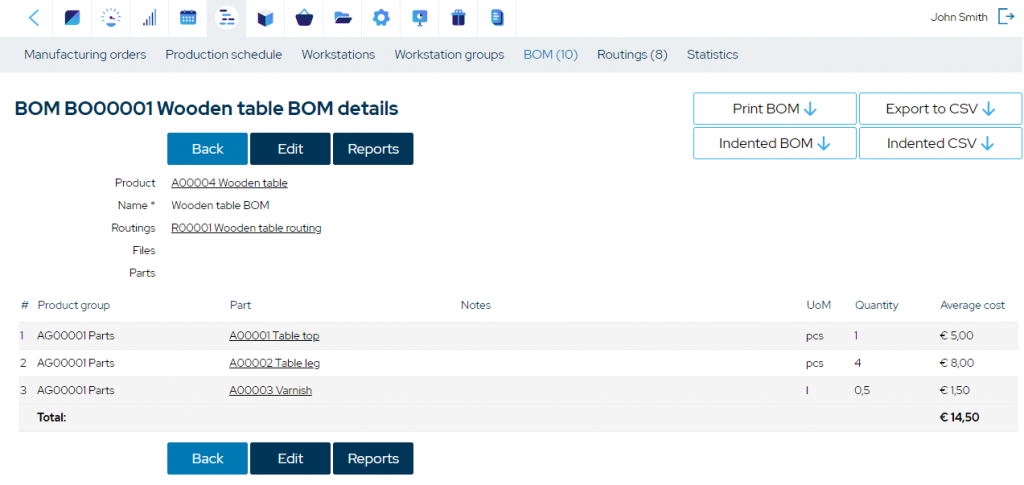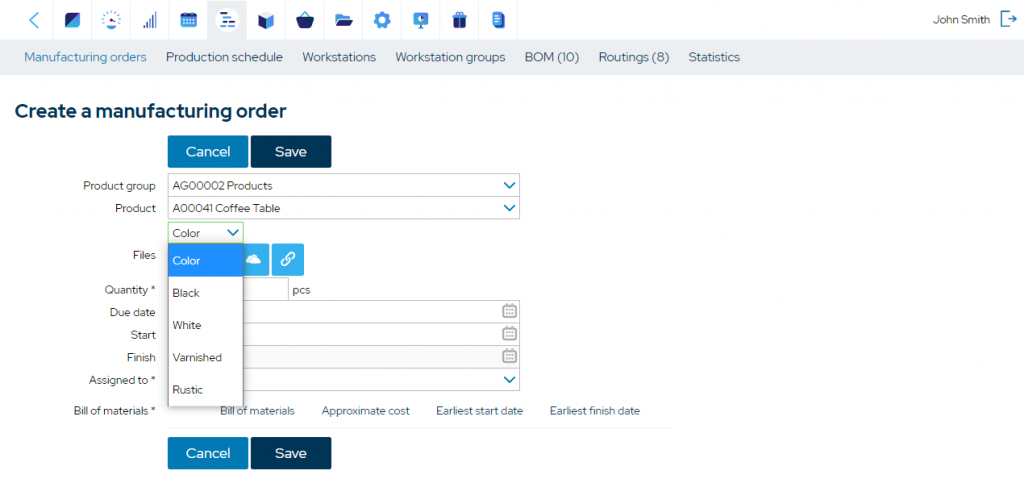
Regardless of the size of the manufacturing operation, a bill of materials (BOM) is vital for production. Manufacturers utilize them as the guide and recipe for creating a final product and as such, they are tied into production, quoting, purchasing and many other areas of manufacturing.

You can also listen to this article:
Table of Contents
A bill of materials (BOM) is a comprehensive list of all the materials, components, and subassemblies required to manufacture a product. A BOM essentially provides a structure for making a product repeatably every time, thereby introducing a basis for standardization in the production process.
A bill of materials will contain the quantity or volume of each component used but it may also include additional information such as:
It is easy to assume that small manufacturing companies may not need structured and well-crafted BOMs because with their size and smaller product portfolio, they are well aware of all the parts and raw materials required. It is also easy to assume that because a product is simple or consists of only a small number of components (or a single component), BOMs are not necessary.
However, both of these assumptions are incorrect.
BOMs are a company’s guide and recipe for building their product. Not having a bill of materials, or having an inaccurate BOM, can lead to waste, inefficiency, and errors in the manufacturing process.
It also means that rather than having systemized process data that can be passed on to future employees as the company scales or as employees leave the company, knowledge is fragmented and siloed across several employees or software systems, leaving the company exposed to loss of repeatability.
BOMs are also important as part of materials management, being the jumping-off point for material requirements planning. In addition, having defined bills of materials aids in production process optimization.
Start efficiently managing your BOMs with MRPeasy
There are several types of BOMs used in manufacturing. Bills of materials can be divided into types by their function or their current product lifecycle stage, by their configurability, or by their structure. Let’s take a look at three different ways to categorize them:
The engineering bill of materials is used in the design and engineering of a new product. It is the ground zero for a finished product that lists all parts, components, and materials for the finished product as it was originally designed.
The EBOM is also used by planners, purchasing, and finance to trigger purchases for materials from existing vendors or to source vendors for new materials. They may also include drawings for new parts that will become standard in the manufacturing bill of materials.
An example of an Engineering BOM would be a company that produces a new scooter using 3D printed parts or a revolutionary technology for propulsion. It would contain a detailed list of all parts required to bring the new product to market.
A manufacturing bill of materials (MBOM) is the most recognized form and consists of all materials, assemblies, formulas, or components required to produce a shippable product. This type of BOM may also be tied to the required processes that are to be performed in its production.
It is also used by planners and schedulers for calculating purchase requirements as needed for an MRP or ERP run in companies that utilize automated software to integrate MRP functionality, BOMs, purchasing, and other production-related operations into a single system. Because they also include time factors such as lead time and production time, they help material planners determine when to purchase as well as when to start the production of a particular item.
An example of a manufacturing BOM would be a wooden table. The basic BOM would specify the parts and materials used: four table legs, a table top, and varnish for finishing.

A standard BOM is a type of BOM that represents a fixed, unchanging list of components and materials required to manufacture a specific product. In other words, it is a BOM for a product with consistent features and specifications across all units produced. A standard BOM is used when the products being manufactured are uniform and do not have variations or options. The components and quantities listed in a standard BOM remain the same for every unit produced.
A configurable BOM (also called a Matrix BOM, a BOM with parameters, or simply a product configurator) is a type of manufacturing BOM used to manage the production of configurable products.
Many manufacturing companies produce the same product in a variety of sizes, colors, or other parameters. Some manufacturers also produce the same goods for different brands under a “white label” arrangement. This means that the core product and bulk of manufacturing will be the same, but the final version may differ slightly depending on the customer. This could mean different packaging, volume, unit count, branding or stamping, and other differences to make the product applicable to the customer’s use or brand. The core product, however, is the same.
An example of a configurable BOM would be a furniture manufacturer offering coffee tables in various colors and finishes. The basic structure of the bill of materials would be the same, but the color would be configurable.
A bill of materials with parameters allows for easy management of products with variations in color, size, components, etc.

This is the high-level BOM that lists the materials required to manufacture or assemble the product. If there were subassemblies, mixes, blends, or other components required to produce these materials, they are not listed and the finished component for the final manufacture is all that is shown.
Single-level BOMs may be used as the only guide for production in companies where the product is simple or where it contains few components or where no sub-processing is required downstream.
An appropriate bill of materials example for a single-level BOM would be a furniture assembly and finishing facility where components for tables would be pre-purchased, i.e. a BOM of a table would consist of four table legs, a table top, and varnish.
Like a single-level BOM, multi-level BOMs contain materials and quantities for producing a finished good. However, for complex manufactured products, a multi-level BOM may have several sub-levels that feed into the final top-level BOM.
In multi-level BOMs, the top level acts as the parent item with the second level of one or more components that are blended or assembled acting as the child item. This process may be repeated for third, fourth, and other subsequent levels where the manufacturing company may be vertically integrated enough to produce its own subassemblies or formulations to be added to others and thus feed the next level up.
Information such as cost, lead time, work process, etc. may be added all the way down to the lowest level. This data can then be tied to integrated automation software such as MRP or ERP software to automate purchasing, plan labor, develop schedules, and other operational tasks.

An effective bill of materials brings numerous advantages to product development, manufacturing, and supply chain management:
In essence, an effective BOM serves as a blueprint for successful product development and manufacturing, driving efficiency, accuracy, and collaboration across various stages of the product lifecycle.
The creation of BOMs may vary between companies or industries. In companies where products are very technical, this may be a technical designer or product designer. In many Make-to-Order companies, it may be an engineer or an industrial engineer. BOMs may also be built by those within administrative functional areas such as purchasing, planning, or scheduling provided the person entering the data has the information required to ensure its accuracy.
Production routing is a document that determines the production order of an item, i.e. the sequence of operations that go into manufacturing an end product. In enterprise resource planning systems, the bill of materials and the production routing form a basis for production planning, cost accounting, and many other essential functions of a manufacturing business.
Bills of materials serve as crucial blueprints guiding product creation, but their complexity can vary depending on the intended use. Two fundamental BOM structuring methods, BOM explosion and BOM flattening, stand at opposite ends of this spectrum.
BOM explosion involves dissecting a high-level BOM into its minutest components and materials. This process is essential for precise material planning, accurate cost estimation, and efficient procurement. By unraveling the hierarchical BOM structure, manufacturers gain a clear understanding of the intricate web of components needed, streamlining the production process and ensuring quality control. Engineering software and Product Lifecycle Management (PLM) tools play a pivotal role in automating this explosion process, transforming intricate designs into actionable production plans.
In the context of MRP software, the term ‘BOM explosion’ also refers to using the bill of materials to create demand forecasts for materials and components. For example, when a furniture manufacturer receives an order of 100 tables and 50 chairs, the BOMs of the tables and chairs are multiplied by 100 and 50, respectively, to arrive at the total quantities of the materials needed for fulfilling the order.
On the flip side, BOM flattening is about simplification. It condenses multiple levels of a BOM into a single layer, focusing on immediate parent-child relationships. This method is handy for quick overviews and simplifying communication, but it sacrifices the depth of information that a BOM explosion provides. BOM flattening is particularly useful when presenting summaries to stakeholders or for preliminary discussions, as it emphasizes the main components without delving into granular details.
Both BOM explosion and BOM flattening are integral to efficient production, each serving specific purposes. BOM explosion uncovers the details, while BOM flattening offers a bird’s-eye view. Choosing the right method depends on the task at hand, whether it’s optimizing the production line or conveying project progress to a diverse audience.
An effective and accurate bill of materials requires specific information. This is true of all BOMs but is especially true for those BOMs tied to MRP/ERP software. Without accurate, in-depth data, the lower levels of the BOM may not “roll up” correctly or accurately to the single level. Missing data also degrades the capabilities of the software and makes its benefits less pronounced.
All BOMs should include:
MRPeasy’s BOM functionality allows you to manage even the most complex products and their production processes.
Having an effective BOM systemizes a lot of tasks to improve accuracy and efficiency. Without a BOM, manufacturing operations must create workarounds to determine valuable information related to production and assembly. An accurate and effective BOM streamlines the production process by providing a roadmap or recipe for each finished good, freeing up valuable hourly and management time to commit to the process of production.
Here are a few tips for creating an effective BOM:
By following these steps, you can ensure that the product is made repeatably every time. And while using Excel or other spreadsheet applications to create and manage BOMs is still possible, by using templates or building a BOM from scratch, using dedicated BOM software such as a manufacturing ERP system automates much of the process and facilitates BOM management. This allows companies to customize and tie their BOM into planning, finance, maintenance, and more.
An example of a bill of materials is a wooden table, the BOM of which would list all of the components and materials used in its production: four table legs, a table top, and varnish for finishing.
What is the difference between BOM and BOQ?A Bill of Materials (BOM) outlines components for manufacturing a product, while a Bill of Quantities (BOQ) specifies quantities and costs of materials for construction projects.
What is the bill of materials for a car?The bill of materials for a car includes various components such as the engine, chassis, transmission, wheels, interior parts, electronics, and more, specifying their quantities, relationships, and specifications needed to assemble the vehicle.